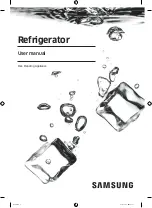
37
Problem
Check
Explanation and Action
Water tank
Water tank
or water supply
or water supply
pipe freezes
pipe freezes
1
1
Are the water supply pipe and water
tank installed to the refrigerator without
any gaps?
Additionally, is the tank pipe installed
to the water tank without any internal
gaps?
Check the installation around the water tank. If there are
gaps, the cold air may escape and water may freeze.
Pages 26 - 27
Ice is small or
Ice is small or
joined together
joined together
1
1
Has ice been stored inside the ice
storage box for a long time?
Ice stored inside the ice storage box for a long time may
shrink or join together (due to a phenomenon called
sublimation).
When not using ice, it is recommended that you remove the
water and stop the ice making.
2
2
Does it occur when the water in the
water tank is decreasing?
As the water in the water tank decreases, the amount of
supply water is slightly reduced.
There is a
There is a
rattling sound
rattling sound
1
1
Are any nearby objects in contact with
the refrigerator?
Leave space around the refrigerator. When objects or walls are in
contact with the refrigerator, sounds may be heard.
2
2
Make sure that the water tank and
water supply pipe are properly
installed.
Push in the water tank until it touches the rear side. If it is out of
position, the sound of the water supply pipe can grow loud.
If there are any gaps or looseness, the water may freeze,
causing sounds to be heard.
Loud noises
Loud noises
Worrisome
Worrisome
noises (Noises
noises (Noises
described on the
described on the
right are normal)
right are normal)
1
1
The noise gets louder suddenly
or the tone changes.
Immediately after beginning use, when the weather is hot,
when the doors are frequently opened and closed, and in
similar situations, the refrigerator switches to high-speed
operation and cools with high power.
2
2
A whistling sound is made after closing a door.
This is the sound of the cooling fan motor starting.
3
3
A whipping or dripping sound is
sometimes heard from inside the
refrigerator after a door is opened.
This is the creaking sound as warm air enters and expands
the plastic.
4
4
Sometimes the sound of fl owing or
boiling water can be heard.
This is the sound of the refrigerant (gas) fl owing.
5
5
A rattling or squeaking sound is made
sometimes (every 1 to 2 hours).
This is the sound of the automatic ice maker. Even when there
is no water in the water tank, the automatic ice maker and pump
make a sound about every 100 minutes.
6
6
After turning on the power, a thumping or
creaking sound may be heard in the ice
making “ICE STOP” mode (every 1 to 2 hours).
This is the sound of the operation check. The check is
performed even in the “ICE STOP” ice making mode.
Doors do not
Doors do not
close
close
Doors open
Doors open
easily
easily
1
1
Is a door making contact with food or a
case? Is too much food packed inside?
Store food so that the door does not make contact with the
food when closed. In the refrigerator compartment, store
food on the shelves and in the drawer doors store food so
that it does not make contact with the ceiling when doors
are shut and opened.
2
2
Has food fallen behind a case in a
drawer door, or is the power cord or
another object trapped between the
refrigerator and a door?
Remove any objects. Make sure that the door does not trap
objects such as food, power cords or plastic bags.
3
3
Is the refrigerator installed stably?
Are the adjustable supports making
contact with the fl oor?
Lower the adjustable supports to raise the front side slightly
and make the doors easier to close.
Page 7
The alarm
The alarm
will sound
will sound
1
1
Check if the doors are closed.
Refer to “When the door alarm sounds” and “When the
alarm cannot be turned off”.
Page 32
Sound
Door
A
utomatic Ice Making
Trouble-
shooting
Summary of Contents for MR-B46Z
Page 78: ...Memo ...
Page 79: ...Memo ...
















































